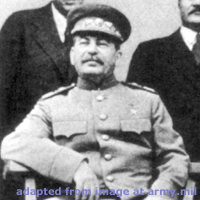It’s Time to Recall Kennan’s Long Telegram and Forget His Later Optimism about Change in Russia

(Window on Eurasia – Paul Goble – August 6, 2015)
Staunton, October 3 – George Kennan’s famous “long telegram” of February 1946 was written to explain to Western leaders something they found difficult to understand: how Moscow could turn from being a wartime ally into an implacable enemy, a problem that some Western leaders are again finding it difficult to understand.
hat makes rereading Kennan’s telegram now especially important, according to Aleksandr Goldfarb, the head of the Litvinenko Foundation in London, especially since as Irina Pavlova, a Russian analyst based in the US, points out, some remain inclined to accept Kennan’s later, more optimistic and fundamentally mistaken views.
In a blog post October 3, Goldfarb describes the atmosphere in which Kennan wrote and its all too disturbing parallels with today’s. Just before the American diplomat penned his cable, President Franklin Roosevelt articulated what was a widespread view among American officials and analysts.
FDR said “I think that Stalin doesn’t want anything except security for his own country. If I give him everything that he wants, then noblesse oblige, he will begin to work for the good of democracy and peace.” On the basis of that assumption, the American president handed over to Stalin all of Eastern Europe.
But in his telegram, Kennan addressed the fundamental error of such assumptions: “Underlying the Kremlin’s neurotic ideas about world politics lies a traditional and instinctive feeling of uncertainty in itself and a fear before more competent, strong and better organized societies.”
“Russian rulers have always felt that their power cannot stand comparison with the political systems of Western countries,” he continued. Thus, Moscow’s aggressiveness had nothing to do with what their Western partners did but reflected “an immemorial Russian complex of incompleteness,” something that could not be addressed by “good will gestures.”
Kennan’s argument became the foundation of containment, which was “based on the understanding that Russian power in principle and by its very nature is not capable of a rapprochement with the free world because it views it as an existential threat to itself precisely because it is free,” Goldfarb writes.
That marked the beginning of the Cold War, a conflict the London-based analyst points out, that in contrast to most wars, did not arise from a single specific act on the part of one side or the other but rather by “an unexpected rethinking of the situation, the destruction of a mistaken picture, and the recognition of reality.”
“So it is today,” Goldfarb argues.
“Over the course of 15 years, the designers of American policy were prisoners of an illusion that Putin, despite all his specific characteristics, could be integrated into the new world system that arose after the Cold War because just like Stalin in the eyes of Roosevelt, he ‘doesn’t want anything except security for his own country.'”
Those who asserted otherwise be they in Russia or the West were dismissed as disturbers of the peace, Goldfarb continues.
As in 1946 so now too, he argues, understanding of Russian realities “arrived unexpectedly and quickly,” a pattern that is shown by the very different reaction of the West to Russia’s invasion of Georgia in 2008 and its response to Ukraine now. The former was viewed as an aberration to be overcome; the latter is increasingly seen as an unpleasant fact of life.
Ever more Western leaders – but of course not all, again like in 1946 – see in front of them a leader and a system which “fears them and hates them” that can only be contained until it can be destroyed.
“If the current situation in Syria had arisen two years ago, then American would have sought points of agreement and mutual profit with Russia,” Goldfarb says. Today, however, Washington recognizes at least in part that “for Putin, [the United States] is enemy number one, just as it was for Stalin.”
Senior American diplomats have confessed as much, the Russian analyst says. “We didn’t fully understand how the Kremlin thought,” one of their number said recently. “We didn’t understand this even during the Cold War. But nonetheless we all the same won that conflict!” May it be so again.
Unfortunately, there is one more obstacle to a return to the insights Kennan offered in 1946 and that is to be found in some of Kennan’s subsequent statements. As Irina Pavlova points out, some of those reflected a baseless optimism in Russia’s ability to change, something the earlier Kennan had rejected.
In response to a question from US Senator Claiborne Pell about whether Russia could ever return to Stalinism, she recalls, Kennan said that he thought that “in this regard, events are irreversible. Today, it is practically impossible to return the country even to Brezhnev’s times” let alone to those of Stalin’s.
“I have no doubt that Mr. Gorbachev will not achieve everything that he wants to achieve. There could be retreats. However, on the whole, he has made progress” which has made almost impossible a return to the past.
Kennan’s point in the late 1980s is indisputable. Gorbachev did make a Russian return to Stalinism “almost impossible.” But the key word here is “almost,” although all too many in the West ignored that – and now Putin has accomplished that, an “achievement” that reflects the underlying realities Kennan himself pointed to in 1946.
Article also appeared at windowoneurasia2.blogspot.com/2015/10/its-time-to-recall-kennans-long.html
